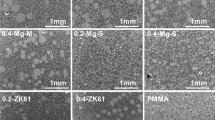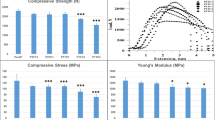Abstract
Poly (methyl methacylate) (PMMA) bone cement is one of the popular bone-repairing materials for fixation of artificial hip joints. Significant problems on the PMMA bone cement are caused by loosening at the interface between bone and the cement, since the cement does not show bone-bonding, i.e. bioactivity. Development of PMMA bone cement capable of bone-bonding has been therefore long desired. The prerequisite for an artificial material to show bone-bonding is the formation of a biologically active bone-like apatite layer on its surface when implanted in the body. The same type of apatite formation can be observed on bioactive materials even in a simulated body fluid (Kokubo solution) with ion concentrations nearly equal to those of human blood plasma. Fundamental researches for bioactive glasses and glass-ceramics revealed that the apatite deposition is initiated by release of Ca2+ ions from the material into the body fluid, and by catalytic effect of Si–OH groups formed on the surface of the material. These findings lead an idea that novel bioactive cement can be designed by incorporation of Si–OH groups and Ca2+ ion into PMMA bone cement. In the present study, PMMA bone cement is modified with 20 mass % of various kinds of alkoxysilanes and calcium salts, and its apatite-forming ability was evaluated in Kokubo solution. The apatite formation was observed on the surface of the modified cements containing 20 mass % of CaCl2, irrespective of the kind of the examined alkoxysilane. On the other hand, the apatite formation was observed on the cement containing CaCl2, Ca(CH3COO)2 or Ca(OH)2, but not on the cement containing CaCO3 or β-Ca3(PO4)2, even when the cement contains 3-methacryloxypropyltrimethoxysilane (MPS). The results indicate that modification with alkoxysilane and calcium salts showing high water-solubility is effective for providing PMMA bone cement with bioactivity. © 2001 Kluwer Academic Publishers
Similar content being viewed by others
References
K. J. Herper, Proc. Inst. Mech. Eng. Part H 212 (1998) 113.
K. D. KÜhn, in “Bone Cements” (Springer, Berlin, 2000) p. 21.
S. Shinzato, M. Kobayashi, W. F. Mousa, M. Kamimura, M. Neo, Y. Kitamura, T. Kokubo and T. Nakamura, J. Biomed. Mater. Res. 51 (2000) 258.
T. Kokubo, J. Ceram. Soc. Japan 99 (1991) 965.
H.-M. Kim, ibid. 109 (2001) S41.
T. Kokubo, H. Kushitani, S. Sakka, T. Kitsugi and T. Yamamuro, J. Biomed. Mater. Res. 24 (1990) 721.
C. Ohtsuki, T. Kokubo and T. Yamamuro, J. Non-Cryst. Solids 143 (1992) 84.
P. Li, C. Ohtsuki, T. Kokubo, K. Nakanishi, N. Soga, T. Nakamura and T. Yamamuro, J. Mater. Sci. Mater. Med. 4 (1993) 127.
S. B. Cho, T. Kokubo, K. Nakanishi, N. Soga, C. Ohtsuki, T. Nakamura, T. Kitsugi and T. Yamamuro, J. Am. Ceram. Soc. 78 (1995) 1769.
C. Ohtsuki, T. Kokubo, K. Takatsuka and T. Yamamuro, J. Ceram. Soc. Japan 99 (1991) 1.
Author information
Authors and Affiliations
Corresponding author
Rights and permissions
About this article
Cite this article
Ohtsuki, C., Miyazaki, T., Kyomoto, M. et al. Development of bioactive PMMA-based cement by modification with alkoxysilane and calcium salt. Journal of Materials Science: Materials in Medicine 12, 895–899 (2001). https://doi.org/10.1023/A:1012876108210
Issue Date:
DOI: https://doi.org/10.1023/A:1012876108210




